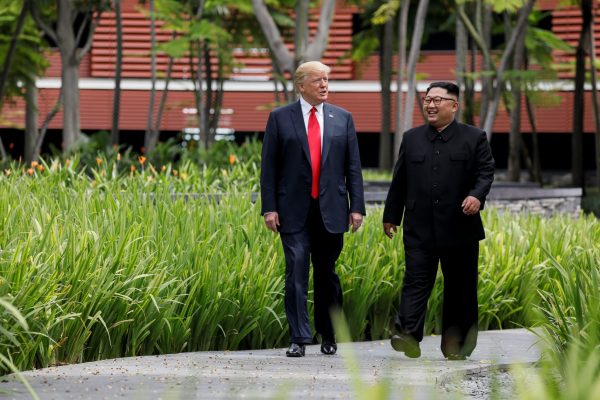That is until earlier this week. On 12 June in Singapore, US President Donald Trump and North Korean Chairman Kim Jong-un paved a path that, if faithfully trod, will close this painful chapter in Asia’s modern history and set the Peninsula on a more hopeful trajectory. The comprehensive and broad principles enunciated in the Trump–Kim joint statement constitute a first step towards reconciliation in the decades-long history of antagonism since the de facto political division of the Peninsula in the mid-1940s.
The outlines of the grand bargain are familiar, symmetric and unprecedented. In exchange for committing to ‘complete denuclearisation’ of the Peninsula on a condensed but step-by-step basis, Pyongyang will receive the security guarantees it craves. As reciprocal commitments are progressively fulfilled and a structure of peace is established, Pyongyang will enjoy sanctions relief and the normalisation of relations with the United States.
The grand bargain constitutes the first time that a North Korean leader has, face-to-face, promised an incumbent US president to work towards the complete denuclearisation of the Peninsula. Equally, the US commitment to guarantee the security of North Korea by means of a legally binding instrument is epochal. By comparison, the joint statement of the six-party talks of September 2005 had merely affirmed that Washington had ‘no intention to attack or invade the DPRK’.
As a down payment, Washington will suspend joint military exercises with Seoul during the negotiations. This is not an exceptional giveaway. In 1992, the Bush Administration suspended the Team Spirit exercises, which led to North Korea signing a safeguards agreement with the International Atomic Energy Agency (IAEA). Further suspensions in 1994, 1995 and 1996 allowed the initialling and early-phase implementation of the US–DPRK Agreed Framework agreement.
For its part, Pyongyang is to facilitate the retrieval and repatriation of the remains of US prisoners of war and those missing in action, maintain its nuclear and ballistic missile research and testing freezes and demolish the large-scale facility in Tongchang-ri. Tongchang-ri is where North Korea conducted combustion tests for the engine that powered its Hwasong-14 intercontinental ballistic missile (ICBM) across the Pacific Ocean last year.
Neither party came away from Singapore entirely fulfilled — especially the US side. The joint statement neither refers to ‘verifiable’ (referenced in the September 2005 statement) or ‘irreversible’ denuclearisation nor formally mentions a ‘verifiable and irreversible’ guarantee to the Kim regime.
But critics miss the point when they argue that the summit laundered Kim Jong-un’s public image but failed to deliver a common definition of ‘denuclearisation’ or a detailed pathway to getting there. That the joint statement fails to elaborate upon a mechanism for public review of the verification provisions — a staple feature of past arms control or disarmament agreements since the Cold War — is also not an insurmountable barrier.
To the contrary, the overarching principles and non-prescriptive nature of the joint statement allows negotiators on both sides to frame the mechanics of denuclearisation flexibly. It was precisely the detailed multi-phase implementation schedule, strung along to the principle of ‘commitment for commitment, action for action’, that ingloriously sank the six-party talks process a decade earlier. And when the Kim regime’s security assurances are to be legally guaranteed, 66 US senators will parse the verification mechanisms with a fine-toothed comb.
Defanging North Korea’s strategic capabilities can proceed on a number of lines. With Pyongyang’s nuclear and ICBM missile-engine testing site already or soon-to-be disembowelled, the logical next targets are its fissile and long-range ballistic missile production capabilities and its deployed, stockpiled and latent nuclear capabilities. The sooner a threshold point of disablement of this strategic capability is achieved, the faster material relief to Pyongyang can flow.
The race to reach this irreversible threshold need not be a drawn-out affair. As pointed out by US Secretary of State Mike Pompeo, a US inter-agency group with more than 100 experts has been meeting regularly over the past three months to address technical and logistical issues related to the disablement of North Korea’s weapons program. In short order, these experts and the IAEA could begin their activities in North Korea. The hard bargaining ahead that Trump has referred to probably pertains to the technical experts’ terms of access to facilities, which will need to be thrashed out with Pyongyang.
The beauty of the flexibly interpretable Singapore joint statement is that none of the material gains to Pyongyang can flow until a threshold point of disablement of North Korea’s nuclear capability is crossed. Kim remains the master of his own destiny (as has been the case since his farsighted New Year’s Day address) and he, himself, holds the key to unlocking it further for the better.
The joint statement does not accept Pyongyang as a de facto nuclear weapons state. North Korea will be denuclearised, by consent or by being compelled.
If the statement contains elements of the ‘freeze-for-freeze’ proposal championed by Beijing, as its critics have disparagingly observed, then they should brace themselves for the other half of Beijing’s formula. The other half involves the ‘parallel-track approach’, whereby denuclearisation is achieved alongside the a peace agreement and the subsequent normalisation of relations.
Sourabh Gupta is a senior fellow at the Institute for China–America Studies in Washington DC. An earlier version of this article was published in the South China Morning Post.

